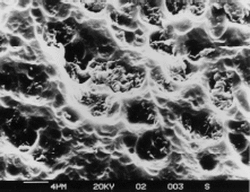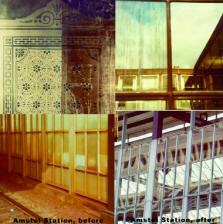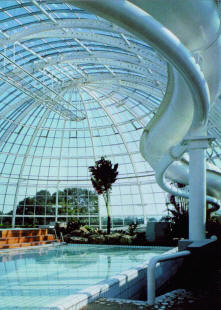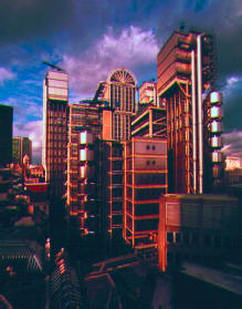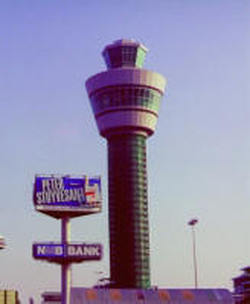Destruction of glass surfaces: Inevitable or preventable?
|
All surfaces are subjected to a weathering process that reduces their performance, damages their appearance and makes their maintenance increasingly difficult. Protective systems are commonly specified for most materials used, such as metals. Unfortunately, in most cases there is still one material that is left unprotected: glass |
New glass is bright and sparkling, easy to see through and easy to clean and keep clean. Contrary to popular belief, the surface of the glass is not completely smooth. It has what glass manufacturers call 'lattice' or 'honeycomb' patterns. Under a microscope, as illustrated in figure 1, glass reveals a rougher surface made of peaks and potholes. Organic and inorganic contaminants fill these potholes and react chemically with the glass, firmly bonding to its surface. As a result, glass easily becomes stained and discoloured, difficult to see through and difficult to clean and keep clean. The surface of the glass also possesses hydrophilic properties and is over time subjected to a corrosion process that will make its surface rougher and therefore its damage greater, in some cases irreversibly. This has great implications on the property owner and any other users of glass, increased costs and efforts in maintenance, renovation or replacement, and in all cases a reduction in the expected performance.
DESTRUCTION OF GLASS SURFACES: THE CAUSE
Just as metal rusts, glass is subjected to a corrosion process caused by reactions between the glass surface and gases in the atmosphere. It is commonly associated with moisture or vapour attack through condensation, or reaction with an alkaline solution. Glass is hydrophilic, meaning it attracts and holds moisture. All glass has a molecular layer of moisture on the surface. When this layer increases because of humidity or rainfall, it can obscure visibility and create a risk to comfort or safety. But most of all, it participates greatly to the destruction of the surface of the glass. There are two distinct stages to the corrosion process, occurring together or separately. The first stage is aqueous corrosion, caused by moisture. It is referred to as ion exchange or alkali extraction (leaching). An ion exchange occurs between sodium ions from the glass and hydrogen ions from the corrosion solution. The remaining components of the glass are not altered, but the effective surface area in contact with the solution is increased. This increase in surface area leads to extraction or leaching of the alkali ions from the glass, leaving a silica-rich layer on the surface. As silica (SiO2) concentration in the glass goes down, surface area increases through dissolution of the glass surface. The pH of the solution in contact with the glass will greatly affect the corrosion process. A rapid pH increase will cause a rapid breakdown of the glass surface. There are two types of aqueous corrosion, static and dynamic. Static aqueous corrosion is caused by an entrapment of moisture on the surface of the glass. In dynamic aqueous corrosion, the corrosion solution is replenished due to condensation run-off. Even a single droplet of moisture on unprotected glass, can produce sufficient damage to be visible in good lighting. The second stage of corrosion is a process of destruction of the leached surface layers of glass. Glass is resistant to most acids but is highly susceptible to attack by alkaline materials, especially a concentration of (OH)- ions giving a pH greater than 9.0. The result is an attack of the network forming silica-oxygen (Si-O) bonds, leading to dissolution of the glass surface. Alkaline cleaning products are readily available and widely used, sometimes indiscriminately, in surface maintenance. Damage to the glass can also be caused by improper and abrasive cleaning methods.
DESTRUCTION OF GLASS SURFACES: A FULL RANGE OF INNOVATIVE AND DURABLE SOLUTIONS
|
The ClearShield System is a unique system that provides a wide range of solutions to all types of glass, in the factory or on-site. The expertise provided covers renovation for glass whose performance has already been greatly reduced through staining and discolouration, and protection and maintenance for new or renovated glass as a preventative measure. Renovation Ritec International pioneered surface protection for the flat glass industry with its ‘non-stick’ surface technology starting back in 1982. Extensive research and experience have resulted in the understanding and expertise in the renovation of glass.
|
The ClearShield System removes all contaminants without creating further abrasion on its surface following the corrosion process described above. Organic and inorganic contaminants deposit on glass and bond firmly to its surface. Ritec has developed a full range of innovative solutions to efficiently remove such contamination. Through work carried out in many different types of environments, from marine vessels to buildings in different climates, renovation has been made possible by breaking the bond between the contamination and the glass, avoiding as much as possible the use of abrasive compounds and methods. Many glazed areas have benefited from the process, bringing glass to an ‘as new’ condition. Its intended performance of visibility, clarity and cleanliness restored, as illustrated by photographs 1 to 4.
ClearShield Protection
ClearShield, a special polymeric resin, provides the protection. It chemically bonds with the glass at a molecular level to modify its surface properties. ClearShield possesses special cross-linking properties that ensure the durability of the protection it provides. When applied, the polymer forms a very strong chemical bond with the glass and with itself, creating a new multi-molecular surface that becomes part of the glass. The multi-molecular surface was confirmed following surface analysis carried out by the ISST (Institute of Surface and Technology) using an Auger electron spectrometer. This machine allows elemental analyses and measures compositions with atomic layer resolutions on extremely small areas of the glass surface.
ClearShield follows the contours of the glass and is less than a micron thin. It is also important to note that ClearShield will not bond to any surfaces other than vitreous. It washes off other surfaces with normal cleaning methods, such as soap and warm water. Unprotected, high-maintenance glass is now converted into ClearShield ‘Non-Stick’ Glass. The surface of ClearShield Glass is totally inert when cured. The Clear-Shield surface therefore acts as a barrier against the bonding of contaminants, and is more resistant than ordinary glass against the attack of moisture and alkalinity. The result is greater ease of cleaning and a durable resistance to staining. ClearShield Glass also effectively resists microbial adhesion for a higher hygiene.
|
In 2003, ClearShield® 'non-stick' easy-clean glass surface treatment was applied to glass throughout the newly built Bangkok Airport. ClearShield® significantly reduces glass maintenance and prevents the build-up of dirt and other contaminants for a long-lasting pristine appearance between cleaning cycles. This video from 2017 demonstrates the durability of ClearShield® protection 14 years after the original application, with the glass still looking great! ClearShield's unique polymer-based 'non-stick' technology bonds with the glass, providing exceptional durability. Unlike a coating, it will never crack, peel or discolour. |
|
